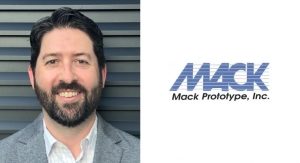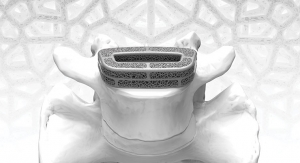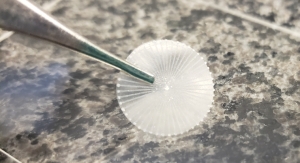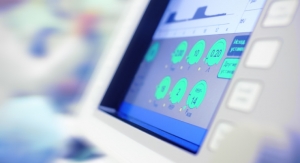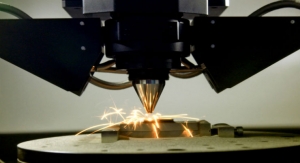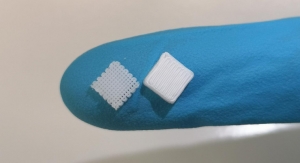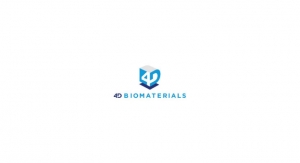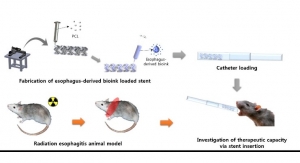Videos
3D Printed Sugar Scaffolds: A Sweet Solution for Tissue Engineering & Device Manufacturing
3D Printed Sugar Scaffolds: A Sweet Solution for Tissue Engineering & Device Manufacturing
Produces a delicate network of thin ribbons of hardened isomalt, the type of sugar-alcohol used to make throat lozenges.
By Liz Ahlberg Touchstone, Biomedical Sciences Editor, Illinois News Bureau05.24.18
University of Illinois engineers built a 3D printer that offers a sweet solution to making detailed structures that commercial 3D printers can’t: Rather than a layer-upon-layer solid shell, it produces a delicate network of thin ribbons of hardened isomalt, the type of sugar alcohol used to make throat lozenges.
The water-soluble, biodegradable glassy sugar structures have multiple applications in biomedical engineering, cancer research, and device manufacturing.
“This is a great way to create shapes around which we can pattern soft materials or grow cells and tissue, then the scaffold dissolves away,” said Rohit Bhargava, a professor of bioengineering and director of the Cancer Center at Illinois. “For example, one possible application is to grow tissue or study tumors in the lab. Cell cultures are usually done on flat dishes. That gives us some characteristics of the cells, but it’s not a very dynamic way to look at how a system actually functions in the body. In the body, there are well-defined shapes, and shape and function are very closely related.”
In a paper published in the journal Additive Manufacturing, the research group described the materials and mechanics of free-form isomalt printing. Free-form means that as the nozzle moves through space, the melted material hardens, leaving a sturdy structure behind—like drawing in midair.
Other types of sugar printing have been previously explored, but have problems with the sugar burning or crystallizing, said Matthew Gelber, the first author of the paper who recently graduated from Bhargava’s group with a Ph.D.
The Illinois team found that the sugar alcohol isomalt could work for printing applications and is less prone to burning or crystallization. Then they had to build a printer that would have the right combination of mechanical details to print stable isomalt structures—the right temperature, pressure to extrude it from the nozzle, diameter of the nozzle, and speed to move it so it prints smoothly but then hardens into a stable structure.
“After the materials and the mechanics, the third component was computer science,” Gelber said. “You have a design of a thing you want to make; how do you tell the printer to make it? How do you figure out the sequence to print all these intersecting filaments so it doesn’t collapse?”
The Illinois researchers partnered with Greg Hurst at Wolfram Research in Champaign to create an algorithm to design scaffolds and map out printing pathways.
One advantage such free-form structures hold is their ability to make thin tubes with circular cross-sections, something not possible with conventional polymer 3D printing, Bhargava said. When the sugar dissolves, it leaves a series of connected cylindrical tubes and tunnels that can be used like blood vessels to transport nutrients in tissue or to create channels in microfluidic devices.
Another advantage is the ability to precisely control the mechanical properties of each part of the structure by making slight changes in the printer parameters.
“For example, we printed a bunny. We could, in principle, change the mechanical properties of the tail of the bunny to be different from the back of the bunny, and yet be different from the ears,” Bhargava said. “This is very important biologically. In layer-by-layer printing, you have the same material and you’re depositing the same amount, so it’s very difficult to adjust the mechanical properties.”
Bhargava’s group is already using the scaffolds in a variety of microfluidic devices and cell cultures, and it is working to develop coating for the scaffolds to control how quickly they dissolve. The Additive Manufacturing paper is part of a series of publications based on Gelber’s thesis work that details how to build the printer and the planning algorithms necessary to operate it, as the researchers hope that others can use their models to build printers and explore various applications for isomalt structures.
“This printer is an example of engineering that has long-term implications for biological research,” Bhargava said. “This is fundamental engineering coming together with materials science and computer science to make a useful device for biomedical applications.”
The Beckman Institute for Advanced Science and Technology supported this work through its seed grant program. Bhargava also is affiliated with the Beckman Institute, the Carle Illinois College of Medicine and the departments of electrical and computer engineering, mechanical science and engineering, and chemistry at the U. of I.
Related Searches:


